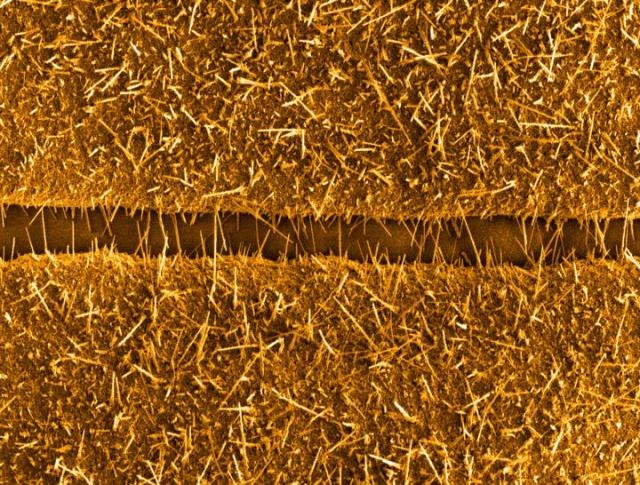May 26 2016
Detecting carbon monoxide (CO) in the air is a significant issue because CO is an environmental pollutant and a poisonous gas. Typically, CO is obtained from the incomplete combustion of carbon-based fuels like gasoline and cooking gas.
 This is an adaptation of a scanning electron microscopy image of copper oxide nanowires bridging the gap between neighbouring copper microstructures (CREDIT: OIST)
This is an adaptation of a scanning electron microscopy image of copper oxide nanowires bridging the gap between neighbouring copper microstructures (CREDIT: OIST)
Detecting CO is a difficult task as it has no color, taste, or odor. Scientists have been exploring sensors capable of determining the concentration of CO. A research team from the Okinawa Institute of Science and Technology Graduate University (OIST) in collaboration with the University of Toulouse has discovered a unique technique to make such sensors.
Copper oxide nanowires that are extremely small are being used by scientists as a tool to detect CO. Upon chemically reacting with CO, these nanowires generate an electrical signal that is capable of being used to quantify the concentration of CO. The extreme thinness of these nanowires allows more than 1000 of them to be fit in the average thickness of a strand of human hair.
The use of nanowires has been hindered by two issues. “The first problem is the integration of nanowires into devices that are big enough to be handled and that can also be easily mass produced,” said Prof Mukhles Sowwan, director of the Nanoparticles by Design Unit at OIST. “The second issue is the ability to control the number and position of nanowires in such devices.” Dr Stephan Steinhauer, postdoctoral scholar at OIST, along with Prof Sowwan and the University of Toulouse researchers might have solved these issues. The research conducted by them was recently published in ACS Sensors.
To create copper oxide nanowires, you need to heat neighbouring copper microstructures. Starting from the microstructures, the nanowires grow and bridge the gap between the microstructures, forming an electrical connection between them. We integrated copper microstructures on a micro-hotplate, developed by the University of Toulouse. A micro-hotplate is a thin membrane that can heat up to several hundred Celsius degrees, but with very low power consumption.
Dr Steinhauer
The use of the micro-hotplate provides scientists with an excellent control over the position and quantity of the nanowires. Moreover, it provides researchers with the required data on the electrical signal that passes through the nanowires.
All this research leads to the development of an outstandingly sensitive device that has the potential to detect extremely low concentrations of CO.
Potentially, miniaturized CO sensors that integrate copper oxide nanowires with micro-hotplates are the first step towards the next generation of gas sensors. In contrast to other techniques, our approach is cost effective and suitable for mass production.
Prof Sowwan
This newly developed technique could also help scientists understand the sensor lifetime in a much enhanced manner. The sensor’s performance eventually decreases and this indeed is a significant problem in gas sensing. This technique delivers data that could improve the understanding of the mechanisms that play a major role behind such phenomenon. Scientists are also provided with details from the beginning of the sensor lifetime. Conventionally, researchers initially grow the nanowires, link them to a device and finally measure the concentration of CO.
Our method allows to grow the nanowires in a controlled atmosphere, where you can immediately perform gas sensing measurements. Basically, you stop growing and start measuring, all in the same location.
Dr Steinhauer